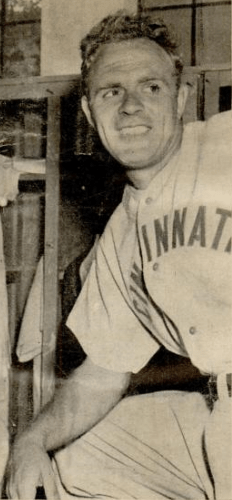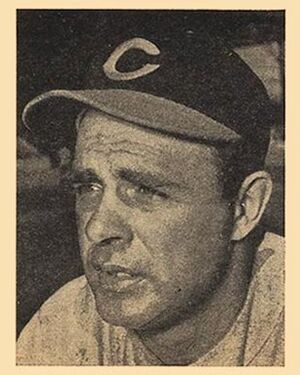Johnny Vander Meer facts for kids
Quick facts for kids Johnny Vander Meer |
|||
|---|---|---|---|

Vander Meer in 1948
|
|||
| Pitcher | |||
| Born: November 2, 1914 Prospect Park, New Jersey, U.S. |
|||
| Died: October 6, 1997 (aged 82) Tampa, Florida, U.S. |
|||
|
|||
| debut | |||
| April 22, 1937, for the Cincinnati Reds | |||
| Last appearance | |||
| May 7, 1951, for the Cleveland Indians | |||
| MLB statistics | |||
| Win–loss record | 119–121 | ||
| Earned run average | 3.44 | ||
| Strikeouts | 1,294 | ||
| Teams | |||
|
|||
| Career highlights and awards | |||
|
|||
John Samuel Vander Meer (born November 2, 1914 – died October 6, 1997) was an American professional baseball player. He was a left-handed pitcher in Major League Baseball. He is best known for playing with the Cincinnati Reds. Vander Meer made history by being the only pitcher to throw two no-hitters in a row. He also helped the Reds win the 1940 World Series. After a great start, he sometimes struggled with his pitching accuracy.
Contents
Johnny Vander Meer's Baseball Journey
Johnny Vander Meer was born in Prospect Park, New Jersey. His family moved to Midland Park, New Jersey in 1918. His baseball career started a bit slowly. In 1933, the Brooklyn Dodgers signed him. He played for their minor league team, the Dayton Ducks.
He was later traded to other minor league teams. These included the Scranton Miners and the Nashville Volunteers. Finally, he joined the Durham Bulls. There, his manager, Johnny Gooch, helped him improve his pitching control. In 1936, he had a great season, winning 19 games and losing only six.
Making History: Two No-Hitters in a Row
Vander Meer joined the Cincinnati Reds in 1937 when he was 22. He played a few games before going back to the minor leagues. But he was called back up in September.
The next year, on June 11, 1938, Vander Meer pitched his first no-hitter. This was against the Boston Bees. A no-hitter means the pitcher does not allow any opposing player to get a hit.
Just four days later, on June 15, he did it again! He threw another no-hitter against the Brooklyn Dodgers. This game was special because it was the first night game ever at Ebbets Field. Johnny Vander Meer became the only player in Major League Baseball history to throw two no-hitters in a row.
Becoming an All-Star Player
Because of his amazing no-hitters, Vander Meer was chosen for the 1938 All-Star Game. He started the game for the National League team. Even though the American League was favored to win, Vander Meer pitched three innings without giving up any runs or many hits. The National League won the game 4–1.
He finished the 1938 season with 15 wins and 10 losses. His earned run average (ERA), which shows how many runs a pitcher allows, was 3.12. He might have won more games, but he was in the hospital for almost a month due to illness.
Challenges and a World Series Win
The 1939 season was tough for Vander Meer. He got sick during spring training. Then he hurt himself slipping on a wet pitching mound. He ended the season with only 5 wins and 9 losses.
In 1940, he started having trouble controlling his pitches again. The Reds sent him back to the minor leagues for a while. He returned in September and helped the Reds win the National League championship. He even scored the winning run in one important game!
In the 1940 World Series, Vander Meer played in one game. The Reds were losing badly, but he pitched three innings without giving up any runs. The Reds went on to win the World Series in seven games. This was his only time playing in the World Series.
Leading the League in Strikeouts
In 1941, Vander Meer's pitching improved. He won 16 games and had six shutouts. He also led the league with 202 strikeouts. A shutout means the pitcher doesn't let the other team score any runs.
He was chosen for the All-Star Game again in 1942. He pitched three scoreless innings once more. He finished the 1942 season with a career-high 18 wins. He also led the league in strikeouts for the second year in a row. In 1943, he led the league in strikeouts for a third straight year.
Serving His Country
On March 3, 1944, Vander Meer joined the United States Navy. He played baseball for the Navy team. He was released from the Navy in December 1945. He missed two years of his Major League career because of his military service. However, he felt that playing so much in the Navy helped him become a more accurate pitcher.
Returning to Baseball
Vander Meer returned to the Reds in 1946. He was 31 years old. He didn't quite pitch as well as he had before. In 1947, his teammate Ewell Blackwell almost threw two no-hitters in a row, just like Vander Meer.
Vander Meer had one more good season in 1948, winning 17 games. In 1950, he was traded to the Chicago Cubs. After one year with the Cubs, he joined the Cleveland Indians in 1951. He played only one game for them before leaving Major League Baseball at age 36.
He continued to play in the minor leagues for five more seasons. In 1952, 14 years after his famous no-hitters, Vander Meer pitched another no-hitter for the Tulsa Oilers.
Career Highlights
Johnny Vander Meer was a four-time All-Star. He finished his 13-year Major League career with 119 wins and 121 losses. He had 1,294 strikeouts and a 3.44 ERA. He also had 29 career shutouts, which ranks him third on the Reds' all-time list.
His 1,251 strikeouts with the Reds were a team record when he retired in 1951. He is one of only six National League pitchers since 1930 to lead the league in strikeouts for three years in a row (1941–1943).
Life After Baseball
After retiring as a player at age 40, Vander Meer became a minor league manager. He managed teams in the Cincinnati Reds organization for ten seasons. He retired from baseball in 1962. After that, he worked for a brewing company.
In 1958, Johnny Vander Meer was part of the first group of players inducted into the Cincinnati Reds Hall of Fame. He passed away on October 6, 1997, at his home in Tampa, Florida, at the age of 82.
Images for kids




